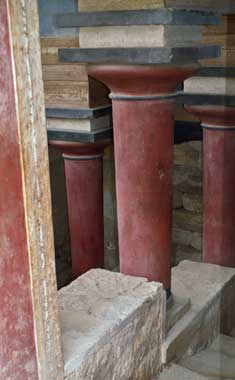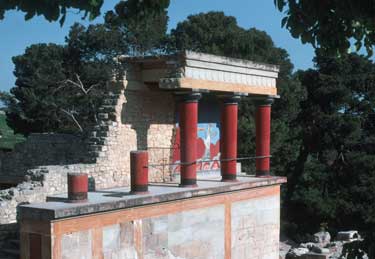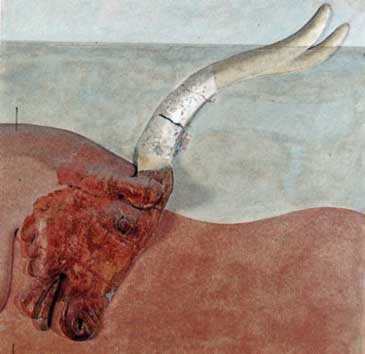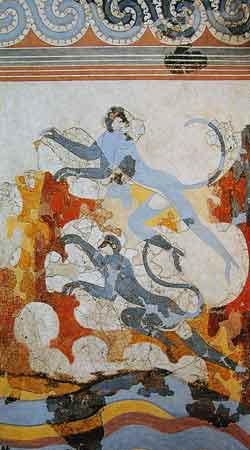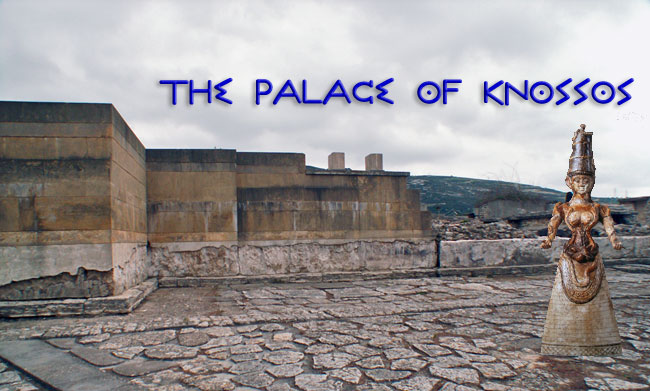
The North Wing
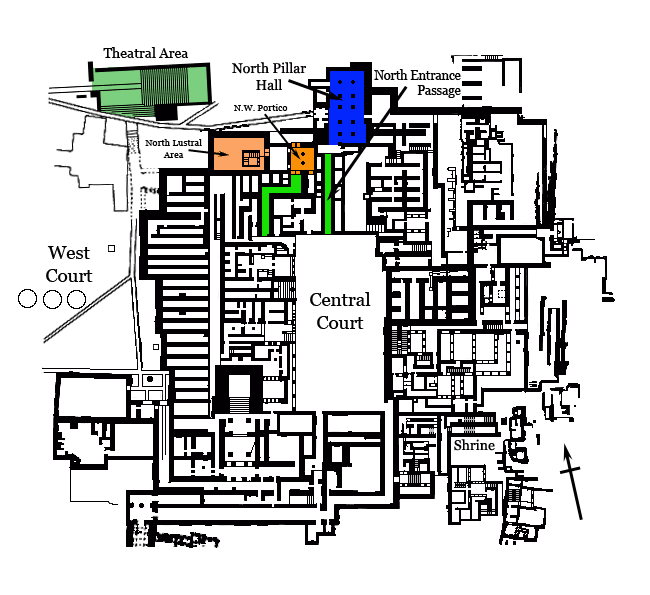
South of the Theatral Area, the causeway branches off with one path heading off to the northwest and the other running alongside the north façade of the palace. Although very little actual paving has survived, it appears that after passing the Theatral Area the causeway curved slightly north, heading to a broad doorway on the west side of the Pillar Hall. Along the way, it passes by an enclosure with a lustral basin and what appears to be another entrance to the palace.
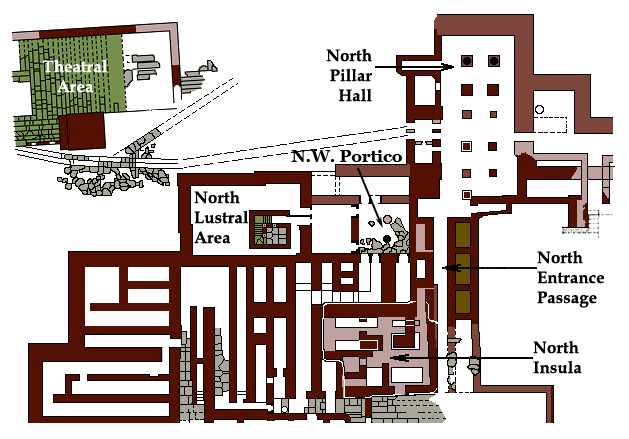
North Lustral Area & North-West Portico
Evans believed there was another entrance to the palace through what he calls the North-West Portico. Although the area was much disturbed, it is pretty clear that there was a set of doors here and a passage 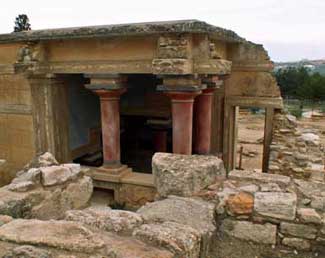 that runs a dog-legged course, avoiding the North Insula, to the Throne Room Suite. Evans found one column base and the setting for another to enable him to reconstruct the porch even though the walls are somewhat conjectural.
that runs a dog-legged course, avoiding the North Insula, to the Throne Room Suite. Evans found one column base and the setting for another to enable him to reconstruct the porch even though the walls are somewhat conjectural.
Immediately next to the porch and connected to it by a pair of doors was the small antechamber of the North Lustral Area (right). To Evans it was the connection was obvious. Visitors who entered here must have undergone ritual purification before proceeding to the heart of the palace. Unlike the anonymous processions that came in through the West Porch, these people would have dealt directly with the ruler of the palace, be that king or goddess.
The lustral basin is fairly typical and sits near the south-eastern corner of a larger enclosure, facing the doors from the antechamber. The southern door led straight to the down staircase. The stepped balustrade supported three tapering columns. The room is a short rectangle measuring about 2.5 x 2.5 metres and is 2 metres deep. The walls had a dado of gypsum slabs and the floor was paved with the same material. Evans found the basin 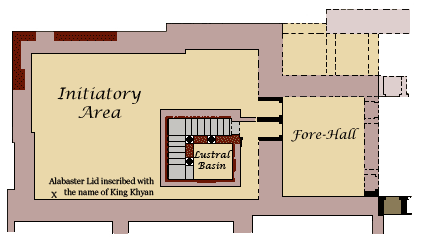 full of carbonized material that had fallen from the upper part of the building. On the floor were clay and stone vessels—the latter including ewers and spouted bowls with inlaid decoration. They were certainly used to pour liquids, scented oils and water, so the ‘lustral’ connection is understandable in this case, at least. Similar vessels were found in the surrounding courtyard along with the lid of an Egyptian bowl bearing the cartouche of the Hyksos pharaoh of Egypt, Khyan who ruled in the 17th century BC.
full of carbonized material that had fallen from the upper part of the building. On the floor were clay and stone vessels—the latter including ewers and spouted bowls with inlaid decoration. They were certainly used to pour liquids, scented oils and water, so the ‘lustral’ connection is understandable in this case, at least. Similar vessels were found in the surrounding courtyard along with the lid of an Egyptian bowl bearing the cartouche of the Hyksos pharaoh of Egypt, Khyan who ruled in the 17th century BC.
It looks as though, after emerging from the lustral basin, the visitor would then turn right and head around the building to take part in other rituals in the open courtyard. The way things are arranged, it looks like groups of people rather than individuals took part.
North Pillar Hall
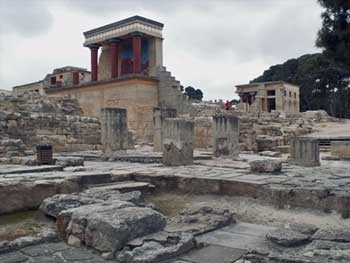 If the visitor to the palace decided to avoid the time consuming rituals involved with visiting the Throne Room, they could swing slightly north and head through a doorway in the west side of the North Pillar Hall (left). This was a large rectangular room (ca. 10 x 22 metres) supported by two rows of pillars. There were 11 of these altogether—6 in one row and 5 in the other—and all were square sectioned save for the two at the north end of the room.
If the visitor to the palace decided to avoid the time consuming rituals involved with visiting the Throne Room, they could swing slightly north and head through a doorway in the west side of the North Pillar Hall (left). This was a large rectangular room (ca. 10 x 22 metres) supported by two rows of pillars. There were 11 of these altogether—6 in one row and 5 in the other—and all were square sectioned save for the two at the north end of the room.
Evans was unsure of the function of the room, which he called the North Pillar Hall, but Graham suggests that it may have been the basement of a Banqueting Hall. Similar halls have been found at the north end of the central courts at Mallia and Kato Zakro.
It is very close to storerooms and pantries containing foodstuffs along with all of the paraphernalia required for its serving and consumption.
North Entrance Passage
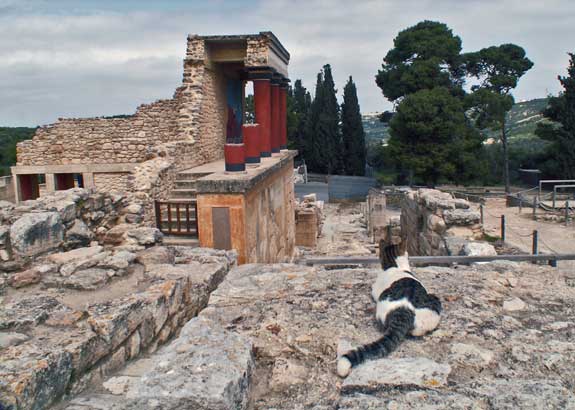
North Entrance Passage
At the southwest corner of the Pillar Hall is an doorway that leads to a long corridor, known as the North Entrance Passage, that gradually slopes up 25 metres to the Central Court. The passage was at most no more than a couple of metres wide and was hemmed in on each side by three bastions built at the beginning of the Second Palace Period.
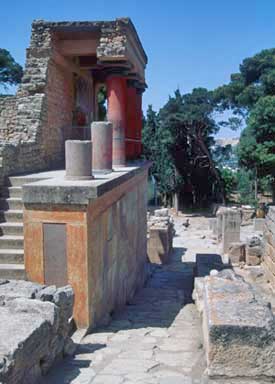 North Entrance Passage from the Central Court North Entrance Passage from the Central Court |
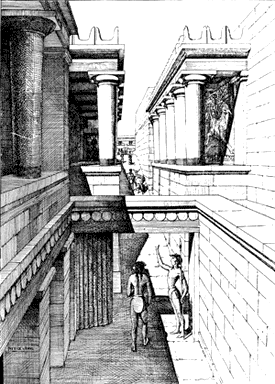 Evans' Drawing of the Reconstructed North Entrance Passage Evans' Drawing of the Reconstructed North Entrance Passage |
On the western side, the bastions supported a magnificent portico which sheltered painted reliefs of what appear to be bull-catching scenes (opposite right), similar to those depicted on the cups found at Vapheio on the Greek mainland. A column base along with fragments of stucco were found in the passage below, enabling Evans to reconstruct porticoed balconies.
The North Insula
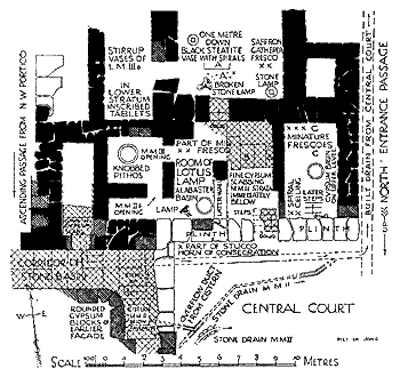 Next to the North Entrance Passage and opening onto the Central Court is a small suite known as the North-West Insula. This block of rooms replaced an earlier structure, the Early Keep as Evans called it, a massive stone edifice containing deep cells. Presumably it had once guarded the northern entrance to the Old Palace. The entire super-structure of the replacement is missing and only basement rooms (mainly used for storage) survive. The suite and whatever lay above it was clearly of some importance because a lot of fine pottery, stone vessels and finely crafted cult paraphernalia was found there.
Next to the North Entrance Passage and opening onto the Central Court is a small suite known as the North-West Insula. This block of rooms replaced an earlier structure, the Early Keep as Evans called it, a massive stone edifice containing deep cells. Presumably it had once guarded the northern entrance to the Old Palace. The entire super-structure of the replacement is missing and only basement rooms (mainly used for storage) survive. The suite and whatever lay above it was clearly of some importance because a lot of fine pottery, stone vessels and finely crafted cult paraphernalia was found there.
One of the rooms contained a fresco depicting blue monkeys who are perhaps gathering saffron from potted crocuses. The action and the rocky landscape is very much the same in wall-paintings found at Akrotiri on the island of Thera which blew apart in the same seismic upheaval that threw down the Old Palace.
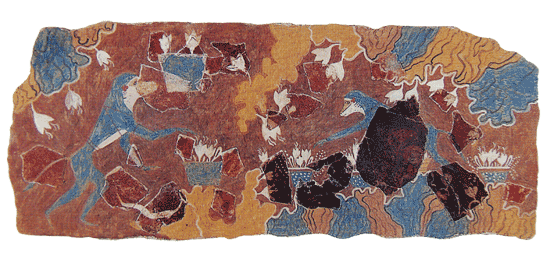
Blue Monkey Fresco
The corner room where the North Entrance Passage met the Central Court had a stucco ceiling with painted spiral reliefs and walls decorated with miniature frescoes. The latter includes the Sacred Grove Fresco and another known as the Grandstand Fresco both of which have been described earlier. The Grandstand Fresco depicts groups of well-dressed women seated prominently on either side of a tripartite shrine and surrounded by crowds of people. There could not be a clearer illustration of the status of women in Minoan society.
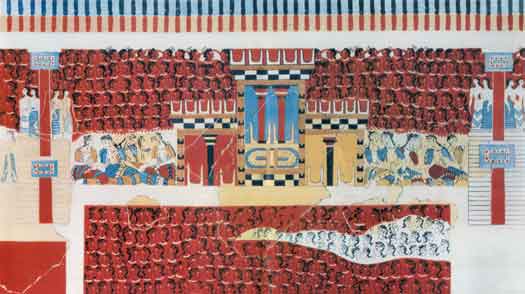
Grandstand Fresco
Unless otherwise stated, all black & white photos of Knossos are from The Palace of Minos by Arthur Evans and are reproduced here courtesy of the Ashmolean Museum, Oxford University

